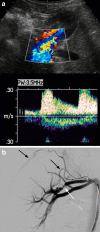Imaging in the evaluation of renovascular disease
- PMID: 19856000
- PMCID: PMC2855432
- DOI: 10.1007/s00467-009-1320-9
Imaging in the evaluation of renovascular disease
Abstract
Renovascular disease (RVD) is an important cause of hypertension in children, as it often is amenable to potentially curative treatment. Imaging aimed at finding RVD therefore needs to have high sensitivity so as not to miss important findings. Digital subtraction angiography is the gold standard investigation. Doppler ultrasonography, computed tomography (CT) angiography and magnetic resonance (MR) angiography can all be helpful, but none has, at present, high enough sensitivity to rule out RVD in a child with a suggestion of that diagnosis.
Figures



References
Publication types
MeSH terms
LinkOut - more resources
Full Text Sources
Other Literature Sources
Medical

